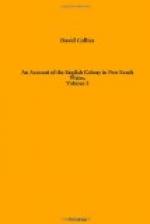CHAPTER XXI
The Norfolk proceeds to Hervey’s Bay
Some account of it
Curlew Island
She returns to Port Jackson
Observations on the currents and tides along the coast
A criminal court assembled
Order respecting the issuing of government notes
Public works
September
A ship arrives from America
The Buffalo sails for the Cape
The governor crosses the Nepean
A calf killed
October
Convicts found on board the Hillsborough and
Hunter
The master of the Hunter tried
A young ox stolen
Ration reduced
Price of Grain fixed
In his passage to Hervey’s Bay, the next place of his destination, Mr. Flinders was not more than two days; passing the Wide Bay of Captain Cook on the 1st and Sandy Cape on the 2nd of August. The southerly wind of the day veering round in the evening to the eastward compelled him during the night to keep at a distance from the land; but, returning to it in the morning, he found that Captain Cook’s description of the coast applied exceedingly well, so far as the distance of the sloop from the shore would enable him to judge.
During this short run he passed one of those spotted flat-tailed snakes which were first noticed by Captain Cook in this latitude, and which appeared to be of the kind observed by Captain Dampier on the north west coast of New Holland. Mr. Flinders had observed the same sort of snake among the islands between New Guinea and New Holland, when on board His Majesty’s ship Providence; it was therefore probable, that it might be found upon most parts of this coast, which were situated within, or in the verge of, the Tropic.
In this bay Mr. Flinders remained until the 7th, during which time he had sailed round the interior of it, but without being able to enter any opening that might have led him to a river. It was deep and extensive, the soundings in it very irregular, and in several places he was prevented by breakers from approaching the shore.
Hauling up for an opening which he was desirous of examining, he came to a small sandy islet, which lay at the mouth of it. Being unable to find a passage into the opening with the sloop, he came to an anchor, and went ashore upon this island, which was surrounded with shoal water. The base of it he found to be a hard stone, over which was a covering of sand, mixed with pieces of coral and shells. There was a little cluster of palms upon it, and some other small trees. Two or three large trees were lying upon the shore, thrown down either by wind or the flood, assisted by the weight of the trees themselves, which the depth of soil was not sufficient to support. They were a tough, hard, and close-grained wood. Being about half ebb, the surrounding shoal was dry. On it were some thousand curlews and gulls, and some pelicans; but all too shy to allow of his approach within musket shot. Upon one of the trees was stuck the cap of a small whale’s skull, and in one of the sockets of the eyes was a bird’s nest apparently of the last season.




